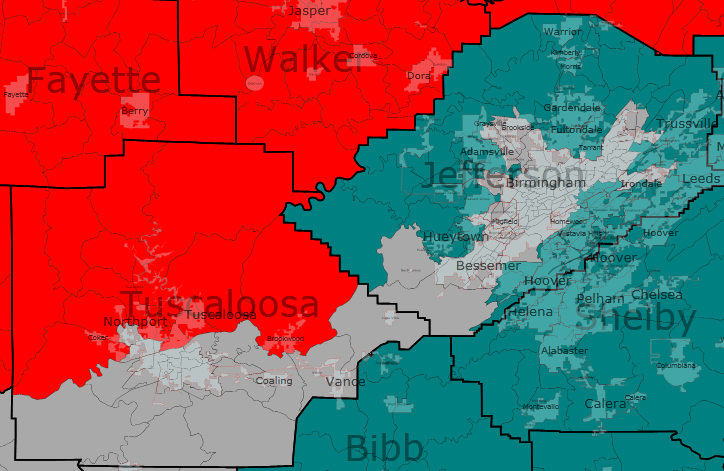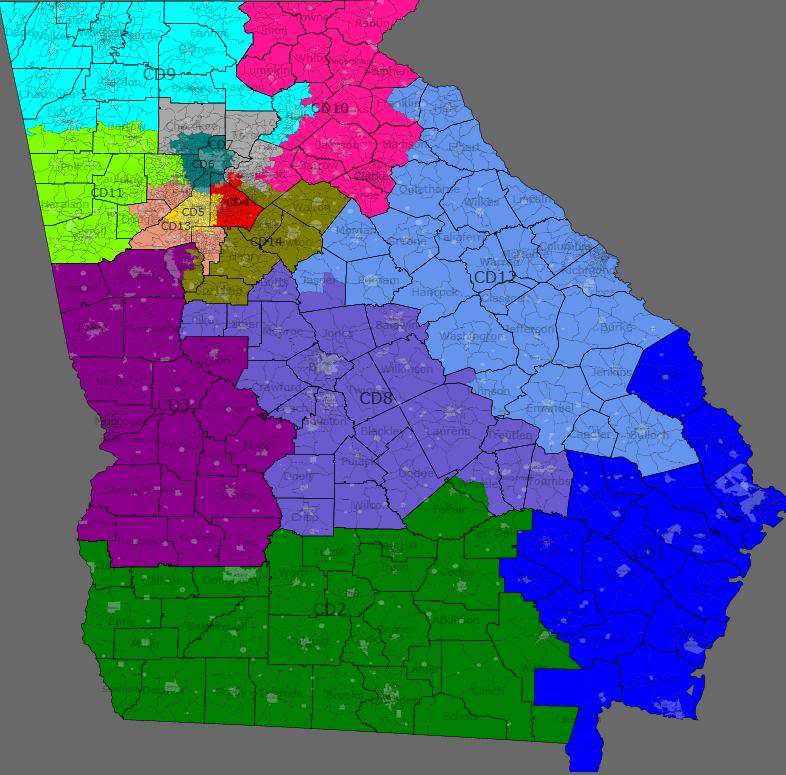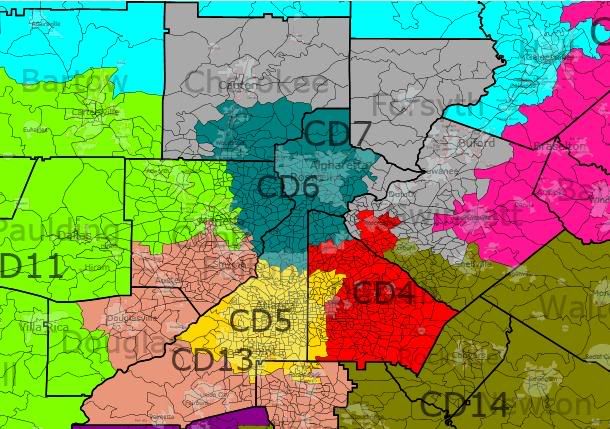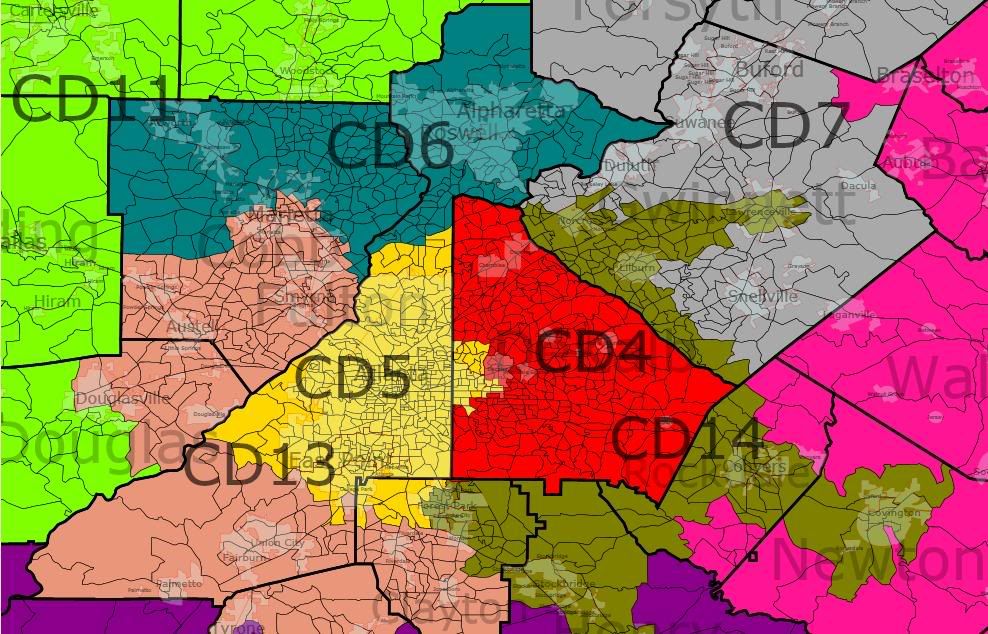On November 3, while voters are going to the polls to decide governors races in New Jersey and Virginia, the fate of gay marriage in Maine, and special elections for congressional seats in California and New York, voters in Georgia will cast votes for municipal elections. In addition, there will be special elections to fill seven vacant seats in the General Assembly: two state senate seats and five state house seats. Here’s a rundown. In summary, there is only one seat (HD-141) that stands a chance off changing parties, but the other ones bear some attention, too.
HD-58
Democrat Robin Shipp resigned to eliminate a conflict of interest between her full-time job as an assistant prosecutor and her part-term job legislator. Divided by the Fulton-DeKalb line, this appears to be the most compact district in Georgia, including the neighborhoods of East Atlanta, Cabbagetown, Reynoldstown, Edgewood, Kirkwood, Ormewood, Boulevard Heights, Eastland Heights, Woodland Hills, Custer/McDonough/Guice, and Benteen.
Four very strong Democrats have qualified. Activist Simone Bell seeks to become the second openly gay member of the General Assembly ever and the first from a racial minority. Her campaign emphasizes women’s and GLBT rights and issues and social justice, including healthcare, education, and safe schools. She had the second best fundraising haul of the five candidates.
Attorney Asha Jackson seems to be the frontrunner, judging from her fundraising prowess (more than her opponents combined). I am a little concerned that her law firm defends tort cases (do they represent insurance companies and incompetent doctors?) and some lack of specifics but nothing I’ve seen has really worried me. I’m wary, but not to the point where I’d reject her.
Activist and businessman Kevin Johnson‘s claim to fame is his advocacy toward gaining more consumer protections from credit card companies, including influencing the recently-passed federal credit card reform legislation. Johnson vows to continue this work if elected, along with working to protect the HOPE Scholarship, Peach Care, and arts education from budget cuts, affordable housing, and high-speed rail.
Michael McPherson is a former General Assembly staffer and has worked on several community boards. Like Asha Jackson, there are some lack of specifics that make me wary to some extent (e.g. “I am dedicated to supporting Georgia’s public schools. We need to find ways to inspire students to remain in school and stay competitive.”), although when he’s more specific, I do like what I see, such as his emphasis on lower carbon emissions, sustainable development, and a regional effort for transportation in the Metro Atlanta area.
For what it’s worth, he’s also the only white Democrat running here.
Josh Lewis IV, an executive with his family-owned surveying company, has also filed as an independent. Interestingly, he filed as J. Lewis IV. I can’t help but to wonder if that’s a ploy to fool people into thinking he’s Congressman John Lewis (or his offspring). His father (judging by the name) was a Mark Taylor supporter, but I can’t find anything on the son.
I expect a runoff, probably between Jackson and either Bell or Johnson (although with low confidence in that prediction) but I’ll say with almost complete certainty that a Democrat will win. My preferences would be, from highest to lowest, Bell, Johnson, McPherson, Jackson.
HD-75
Not far south, Democrat Celeste Johnson resigned her seat in North-Central Clayton County to move to Florida for personal and family reasons. Two candidates have emerged for the special election: Democrat Ron Dodson and Republican Shawn James. Dodson will no doubt win in a cakewalk (I’m expecting at least 60%), having the benefits of party affiliation (2000 census numbers put this district at almost majority black, with another 11% Hispanic added in, numbers that have likely increased since then), first ballot listing, and name recognition (he held this seat before retiring and held other elected positions before that).
However, Dodson sucks. For starters, at the end of his tenure in the state house, he left the Democratic Party to become an independent. And his tenure as state representative does not make me feel warm and fuzzy, such as his failing ratings from the Georgia League of Conservation voters and votes in favor of the gay marriage amendment (and against floor amendments by opponents of the bill). And even in his most recent announcement, he says his big issue is tort reform.
If I lived in the district I’d throw off and allow James to win. He’ll just lose next year and we’ll get something better, hopefully.
HD-129
Left vacant when Republican Vance Smith resigned to take a seat on the state transportation board, we have no chance here: we didn’t field a candidate. Even if we had, our guy/woman would have gotten slaughtered in this blood red, white, rural-exurban district that runs from NW Columbus north. The Republicans fielded four candidates: former State Rep. Earl Davis (who’s seeking to make a comeback after losing over 35 years ago), publications consultant/talk show host Jerry Luquire, businessman and former member of the state licencing board of massage therapists Steve Earles, and Vance Smith’s son businessman Kip Smith.
Pick your poison here. Luquire rants about maintaining the “Biblical” definition of marriage and denying hate crimes protections for gays, along with calling for taxing lottery ticket sales and being anti-Atlanta. Earles goes off about “socialist infringements” on his “conservative way of a life,” seemingly calls the entire Atlanta population “unproductive and welfare dependent” (unspoken racism, you think?) and literally says the best way for the state government to ensure better success at handling issues is to cut staff. Smith goes off on a hardline “no taxes”/”small government” screed, along with ample repetitions of the word “conservative” (makes me think of Sarah Palin and “maverick.”).
I guess that leaves us with Davis, who at least admits government has a use (“To provide those services citizens cannot do themselves – police, courts, parks, education, etc.”) and does accept using the power of the state to force localities to “do what they should have done.” Plus, at 75, his time and ability (due to not being able to build a lot of seniority) to do damage is much more limited than Earles, who’s 56, or Smith (27). Luquire is old too (70) but that’s a lot of batshit to take. I expect a runoff here. If money and insider support are any indication, Smith should get through. Davis hasn’t raised money, instead taking out a $20k personal loan while Earles has had a respectable haul for a state representative seat. Luquire hasn’t filed a report. Earles has the benefit of being from the largest county in the district (although it isn’t dominant), but I’m thinking (and hoping) he and Luquire will split the wingnut votes. With little certainty, I’ll say a runoff between Davis and Smith will happen, with Smith probably getting at least 60% of the runoff vote.
HD-141
Like Vance Smith, Democrat Bobby Parham resigned to take a seat on the state transportation board, leaving his seat open. It consists of all of Baldwin County (Milledgeville) plus a tiny sliver of Putnam County. That sliver is so minuscule (only about 2% of the electorate) that it is almost meaningless, short of a razor-thin margin in Baldwin (and if that happens, we’ve likely lost as Putnam is really Republican).
This is a swingy county, with a propensity for being close (55% or less) no matter how big the state margins are, no matter who. Obama and Bush (both times) narrowly won it. Max Cleland (2002) and Jim Martin (2008-general and runoff) narrowly won it. Sonny Perdue won it in his narrow defeat of Roy Barnes, but, despite a huge win state wide in his re-election bid, narrowly lost it. Zell Miller underperformed there in his 2000 Senate special election. However, Democrats overperformed there in the 2004 Senate election and the 2006 Lieutenant Governor and Secretary of State open seat elections. It’s about 42% or so black and is the site of Georgia College of State University.
Four candidates emerged for the special election: Democrat Darrell Black, and independent Rusty Kidd, and Republicans Angela Gheesling-McCommon and Casey Tucker. Tucker, a recent college grad, is your run-of-the-mill wingnut: a gun nut, a tenther, tax cuts solve everything, government is evil. Gheesling-McCommon, the executive director of the local development authority, seems like an empty slate of sorts, with no real positions anywhere. Kidd, a lobbyist, has a good position on stem cell research (I would imagine his being paralyzed from the chest down would give him perspective), but nothing else seems notable one way or another. Black, a local businessman, has some good positions, calling for green jobs and banning insurance companies from denying coverage due to pre-existing conditions.
If there is a runoff, which I expect, I would expect Black to get through due to his party affiliation (and lack of split) and being first on the ballot, along with either Kidd or Gheesling-McCommon; Tucker just seems too new to this to get farther. Kidd seems more likely based on his huge fundraising but the lack of party affiliation and lower ballot slot may hurt him. Hopefully, the Republican flank will be split enough to deny them anything in the runoff. I’m not sure where Kidd’s support will come from, though.
HD-159
Republican Buddy Carter resigned his seat in the crimson, Northern suburbs of Savannah to run in the special election for SD-01. Not long after that announcement, former State Rep. Ann Purcell announced her candidacy. Purcell switched from Democrat to Republican after redistricting but still lost in the primary to Carter, who is now endorsing her! Some Republicans have objected to the way things have gone down here along with the fact that Purcell used to be a Democrat and have run their own candidate, 25 year-oldJesse Tyler, who has made it known that he’s a “true conservative.”
Despite that disatisfication, Purcell will have the advantages of name recognition, money, elite support, experience and will probably be the choice of whatever Democrats and moderates that are in the district due to her being a former Democrat and ostensbily less conservative. I expect at least 60% for her.
SD-01
Republican Eric Johnson resigned his seat to get around fundraising laws preventing him from raising money for his gubernatorial run during legislative sessions. Two Republicans are in the race: the aforementioned former State Rep. Buddy Carter and former Chatham County Commission Chair Billy Hair. This does not appear to be another case of Dodson vs. James or Purcell vs. Tyler. This one looks like it will be competitive. Still, Carter has a huge money advantage, so I’m expecting him to prevail.
Hair is big on school vouchers and privitization, but he at least says we should fund mental health and trauma care. Carter is a tort reformer and a no taxes hardliner. I guess I’d say Hair is the lesser of two evils.
SD-35
Democrat Kasim Reed resigned his seat in South Fulton, South Atlanta, and parts of Eastern Douglas County to run for Mayor of Atlanta. And the floodgates opened; nine candidates have emerged, all Democrats. Kezmiche Atterbury, who mentions her work for various non-profits and government positions to increase minority enrollment in medical schools and streamline state children’s healthcare programs, promises to increase school funding (higher teacher pay, more teachers, etc), better funding Grady Hospital and its level 1 trauma care, and increasing mass transit (including expanding MARTA). Other than mentioning his work on affordable housing and a goal of a clean environment, Benny Crane doesn’t give much information.
Rosie Jackson talks about issues in a roundabout way, emphasizing her advocacy work on eliminating funding disparities between the white, Republican, well-to-do North Fulton and the black, Democratic, poorer areas in South Fulton and providing health clinics to these areas. Former State Senator Donzella James emphasizes afterschool programs to help prevent crime, better pay and benefits for teachers, and universal healthcare coverage.
Other than decrying cuts to education, Aaron Johnson really doesn’t say a whole lot, other than murky priorities. Torrey Johnson believes healthcare is a right, promises to work to reduce teacher-student ratios, requiring more notification for impending layoffs, and a six month moratorium on foreclosures. Attorney Cory Lynch doesn’t say much of any real use (other than increasing teacher pay and tax breaks for teachers). Demarcus Peters deserves some attention for at least mentioning, among other things, the need to preserve greenspace and increase consumer protections. Registered nurse George Sneed explicitly states that he would support the/a public option, creating state funding for MARTA, increasing teacher pay, and extending the grace period.
Although counties like Douglas (re: bluing, inner/middle ring suburbs) have Democrats representing parts of their area, those Democrats are always from an inner county like Fulton, Clayton, or DeKalb. I would like to see that change so we can build a bench in these bluing counties. The only one that would qualify would be Peters. However, I am not going to sacrifice issues for geography. My preferences are Torrey Johnson, Sneed, James, Atterbury, Jackson, Crane, Lynch, and Aaron Johnson, in that order. It’s hard to gauge a front runner with many candidates having not filed a campaign finance report yet (and those that have haven’t put up anything astonishing).






